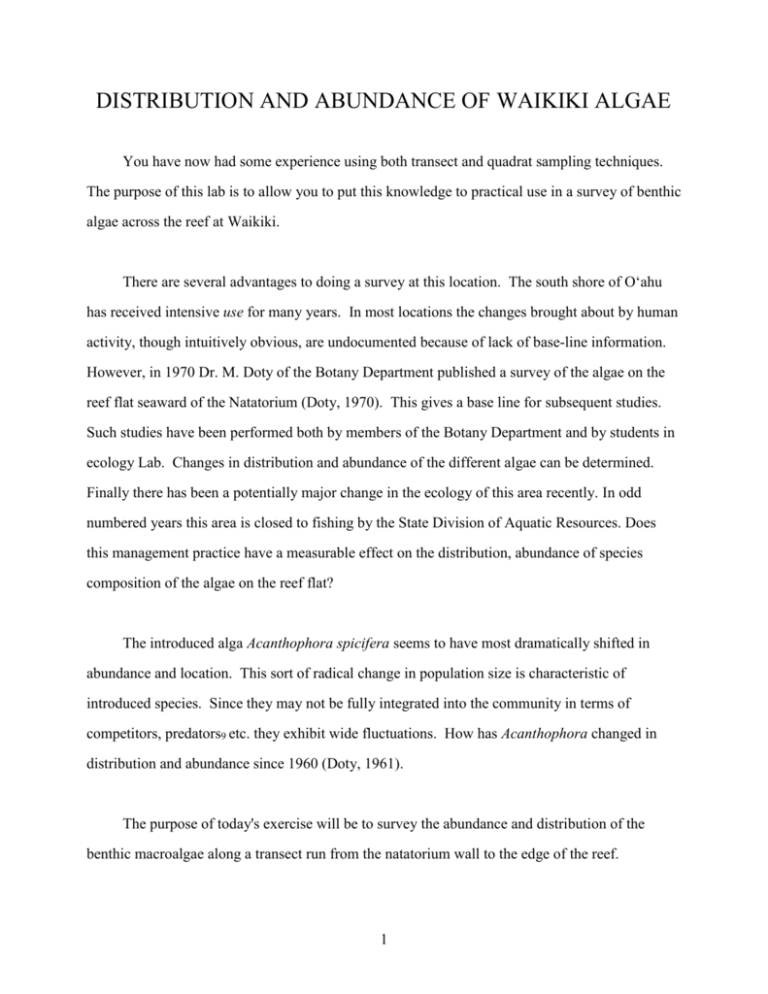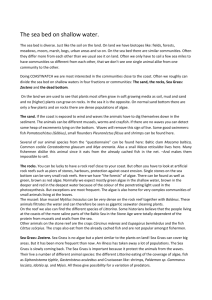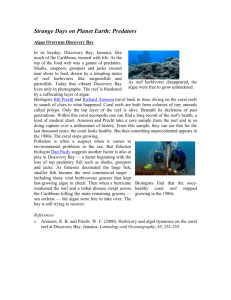Lab Handout (MS Word format)
advertisement

DISTRIBUTION AND ABUNDANCE OF WAIKIKI ALGAE You have now had some experience using both transect and quadrat sampling techniques. The purpose of this lab is to allow you to put this knowledge to practical use in a survey of benthic algae across the reef at Waikiki. There are several advantages to doing a survey at this location. The south shore of O‘ahu has received intensive use for many years. In most locations the changes brought about by human activity, though intuitively obvious, are undocumented because of lack of base-line information. However, in 1970 Dr. M. Doty of the Botany Department published a survey of the algae on the reef flat seaward of the Natatorium (Doty, 1970). This gives a base line for subsequent studies. Such studies have been performed both by members of the Botany Department and by students in ecology Lab. Changes in distribution and abundance of the different algae can be determined. Finally there has been a potentially major change in the ecology of this area recently. In odd numbered years this area is closed to fishing by the State Division of Aquatic Resources. Does this management practice have a measurable effect on the distribution, abundance of species composition of the algae on the reef flat? The introduced alga Acanthophora spicifera seems to have most dramatically shifted in abundance and location. This sort of radical change in population size is characteristic of introduced species. Since they may not be fully integrated into the community in terms of competitors, predators9 etc. they exhibit wide fluctuations. How has Acanthophora changed in distribution and abundance since 1960 (Doty, 1961). The purpose of today's exercise will be to survey the abundance and distribution of the benthic macroalgae along a transect run from the natatorium wall to the edge of the reef. 1 You will describe a) the zonation of the algae from the shore to the reef crest b) the associations between important species; c) the diversity of the plant community at different distances from shore; d) the biomass of algae at different distances from shore. Transect lines will be laid out on the reef from the natatorium to the reef crest (about 200 m). Sampling stations will be placed in a regular manner at 10 m intervals along this line. At each station a 1 x 1 m grid will be placed on the reef. This grid has 25 marked points where strings intersect. You will note what algae lie under these intersections. This will give you an estimate of percent cover by each species. In addition at each station a 20 x 20 cm quadrat will be haphazardly placed and all the algae within the quadrat will be collected and placed in a plastic bag marked with the station number. Because of the limited time it will be most efficient if the class breaks up into 3 or 4 groups. In each group one or two people will place the large quadrat with the grid and give the information to the recorder. One person will record the information from the grid sample and one person will place the small quadrat and scrape off the algae for the biomass sample. Thus one group might start at station #1 (0 m) while the next group will start at station #4 (50 m) and so on. The whole transect will be about 200 m kg. We will then return to the lab, transcribe the notes from the U/W slates to computer files and sort and weigh the algae. 2 In your data analysis you should cover the following points. 1) How MANY SPECIES are there and how are they DISTRIBUTED? (How does this differ from previous years?) 2) Are some species COMMON and others LESS so. Which ones (How does this differ from previous years?) One way of looking at the question of commonness and rarity in community situations is by using the concept of DIVERSITY (Krebs, Ch. 23 Peet, 1974; Pielou, 1966). For consistency we will use the Shannon Wiener function H where H = - pi log pi where pi is the proportion of the ith species in each sample. To simplify the calculations you may use the tables in Lloyd and Ghelardi (1964) and Lloyd et al. (1968). But first make sure you have carefully read the chapter on diversity so you UNDERSTAND what you are doing; don't just grind out numbers. You should be able to make insightful statements about changes in community structure through time by judiciously using measures of species diversity and equitability. 3) Another sort of question you should approach is that of SPECIES ASSOCIATION. Are some species typically found together? Is this a result of species interaction, or simply that the species share the same habitat requirements? How could you separate these two possibilities? Chapter 19 in Krebs discusses these aspects of community ecology and gives some techniques for answering such questions. Multi species analyses can become quite cumbersome. And even for the Chi square test of 2 x 2 contingency table data, relatively 3 large sample sizes are needed. BUT you should be able, by using insights gained from looking at the data, ask some pertinent questions about the species that are in such abundance that you can perform statistical tests, Remember you are analyzing a community that has changed considerably through time and also that seasonal and chance changes may be superimposed on any long term trends. USE YOUR HEAD. REFERENCES Doty, M. 1961. Acanthophora, a possible invader of the marine flora of Hawaii. Pac. Sci. 15 547-552. Doty, M. 1970. The standing crops of benthic frondose algae at Waikiki Beach, 1966-1969. Hawaii botanical Science Paper #11, 282 pp. Glenn E.P., Smith C.M. & M.S. Doty 1990. Influence of antecedent water temperatures on standing crop of a Sargassum spp. dominated reef flat in Hawaii. Marine Biology 105: 323328. Kinzie III, R. A. 2008. Four decades of macroalgal stasis and change on an urban coral reef. Micronesica 40: 101-122. Lloyd, M. and R. J. Ghelardi. 1964. A table for calculating the "equitability' component of species diversity J. Anim. Ecol. 33:217-225. Lloyd, N., J. H. Zar and J R. Karr. 1968. On the calculation of information theoretical measures of diversity. Am. Midl. Natur. 79: 257-272. McCook M.J. 1999. Macroalgae, nutrients and phase shifts on coral reefs: scientific issues and management consequences for the Great Barrier Reef. Coral Reefs 18:357-367. Peet, R. K. 1974. The measurement of species diversity. Ann. Rev. Ecol. and Syst. 5:285-307. Pielou, B. C. 1966. The measurement of diversity in different types of biological collections J. Theor. Biol. 13: 131-144. Smith J.E., Hunter C.L., Conklin E.J., Most R., Sauvage T., Squair C. & Smith C.M. 2004. Ecology of the invasive red alga Gracilaria salicornia (Rhodophyta) on O‘ahu, Hawai‘i. Pacific Science 58:325-343. 4 Smith J.E., Hunter, C.L. & Smith, C.M. 2002. Distribution and reproductive characteristics of nonindigenous and invasive marine algae in the Hawaiian Islands. Pacific Science 56:299315. 5









